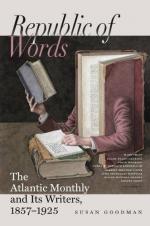Just as the disc started on that fatal dispatch, and Cogs bent over it to read, his spirit-lamp blew up,—as the dear things will. They were beside themselves in the lonely, dark office; but, while the men were fumbling for matches, which would not go, Cogs’s sister, Nydia, a sweet blind girl, who had learned Bain’s alphabet from Dr. Howe at South Boston, bent over the chemical paper, and smelt out the prussiate of potash, as it formed itself in lines and dots to tell the sad story. Almost anybody used to reading the blind books can read the embossed Morse messages with the finger,—and so this message was read at all the midnight way-stations where no night-work is expected, and where the companies do not supply fluid or oil. Within my narrow circle of acquaintance, therefore, there were these simultaneous instances, where the same message was seen, heard, smelled, tasted, and felt. So universal is the dot-and-line alphabet,—for Bain’s is on the same principle as Morse’s.
The reader sees, therefore, first, that the dot-and-line alphabet can be employed by any being who has command of any long and short symbols,—be they long and short notches, such as Robinson Crusoe kept his accounts with, or long and short waves of electricity, such as these which Valentia is sending across to the Newfoundland Bay, so prophetically and appropriately named “The Bay of Bulls.” Also, I hope the reader sees that the alphabet can be understood by any intelligent being who has any one of the five senses left him,—by all rational men, that is, excepting the few eyeless deaf persons who have lost both taste and smell in some complete paralysis.




